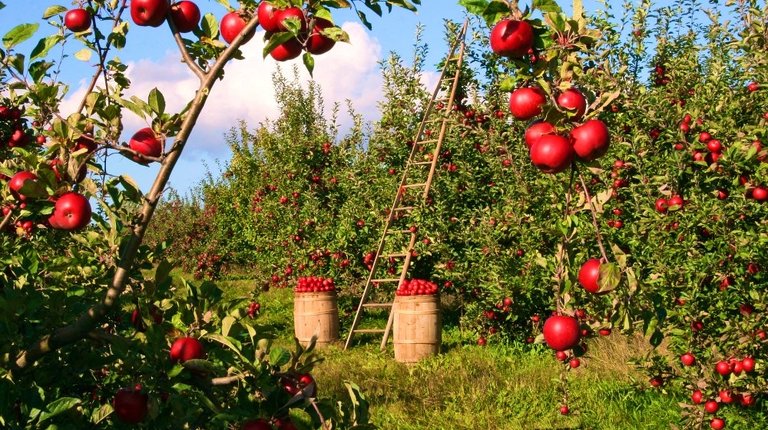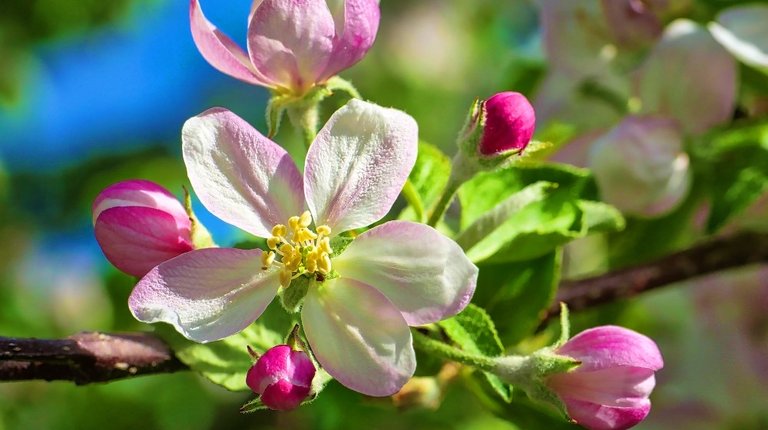Wishing you all a wonderful evening. This is my first article and also the first part of my series about apple trees, apples, and old varieties. I plan to continue this series and I would be very happy if you enjoy reading it as well as I enjoyed writing it.

Source editing by @oneofsteem
This is an autumn day ...
(Christian Friedrich Hebbel, 1813-1863)
(I tried to translate this beautiful poem for you as best as possible.)
This is an autumn day like I didn't see any!
The air is still as if you barely breathe,
And yet fall rustling, far and near,
The most beautiful fruits from every tree.
O does not disturb her, the celebration of nature!
This is the harvest that she holds herself,
Because today only detaches itself from the branches,
What falls from the mild ray of the sun.
Here is the original German version:
Dies ist ein Herbsttag ...
(Christian Friedrich Hebbel, 1813-1863)
Dies ist ein Herbsttag, wie ich keinen sah!
Die Luft ist still, als atmete man kaum,
Und dennoch fallen raschelnd, fern und nah,
Die schönsten Früchte ab von jedem Baum.
O stört sie nicht, die Feier der Natur!
Dies ist die Lese, die sie selber hält,
Denn heute löst sich von den Zweigen nur,
Was von dem milden Strahl der Sonne fällt.
It certainly seems strange to many to start the first post ever with a German poem, but feelings, sensualities, and moods of an autumn day I can best express in German. In this poem, Hebbel describes the autumn days somewhere in Germany. Leaves fall, people breathe the fresh, healthy air and when you look at the ground you discover a variety of the most beautiful fruits that nature grants us.
I would like to tell you more about one of the most wonderful, healthiest, most splendid and species-rich fruits - the apple.
It is far from my intention here to give a treatise on pomology at its best, but nevertheless, I would like to write a few lines about the history and origin of the apple.
The apple (Malus) or the cultivated apple (Malus domestica) is a rose plant (Rosaceae). Science has long assumed that the apple is a crossbreed with the so-called wild apple (Pyrus malus). However, recent genetic research has shown that the apple is probably a crossbreed between the Asian wild apple and crossbreeds between the Caucasus apple and/or the Cherry apple.
Its home could be Kazakhstan, whose capital Alma-Ata means "City of Apples". The global spread of the apple can only be speculated about. The spread through Asia via trade routes to Europe is probably one option. Via Greece, it reached Rome and from there to Germania.
In ancient Germania only the sour and very hard Wood Apple was known; from the Romans, they learned how to refine apples - the so-called plug.
Around 1170, the Cistercian monks first mentioned a variety of apple, the so-called "Borsdorf Apple". More than 20,000 apple varieties were known worldwide around 1880; 2,300 varieties were known in Prussia alone. At the time of industrialization in the 20th century, cultivation and breeding for the supply of the population was strongly promoted and also supported by pomologist associations. There was an enormous regional variety diversity. Today we owe it to the pomologists of that time through their studies and records that many old varieties are known still and have been newly bred and reactivated for the past 30 years.
Today there are still 1,500 varieties in Germany, of which only 60 varieties are economically significant. Only 30 to 40 varieties are currently available from retailers and direct marketers - the trend is downward. We often only find 5 to 10 global varieties in the supermarket displays.

Source editing by @oneofsteem
My beloved partner @anutu and I have been living on the very apple-poor island of Malta for quite some time now. Even though we feel incredibly comfortable here, do our work, have many friends and are honestly happy, I miss my home country Germany in autumn.
In the past years, we often drove to the country and walked through villages, woods, and fields and very often we came to abandoned fruit alleys. Country roads, sometimes in the middle of nowhere, full of fruit trees. Those alleys were planted in the 18th and 19th centuries and cared for from generation to generation. The idea at that time was that all people could take from the fruits of the trees, whether poor or rich. Everyone could help themselves to collect, depending on the season, cherries, plums, mirabelles, pears, quinces and even apples for their needs. Especially people who were poor or destitute were able to cover their needs for vitamins and minerals.
To be continued today in part 2 ...
Unbelievable amounts of information about the apple! who knew all this??? wow!!!
I'm sure that it must be very difficult to be without certain foods in a new country. When we visited overseas, (thinking that we might live in other countries) one of the most difficult things to overcome was FOOD! Can you believe it??? but it's true! We don't realize how much we take certain foods for granted until we can't have them!
Can you plant an apple tree there? Or does the climate now allow for it?
Yeahhh @dreemsteem ... how can one know so much about apples ... wow! And in the second part @oneofsteem mentioned that a continuation will be published ... oh I think this will get interesting :)
You just planted 0.10 tree(s)!
Thanks to @anutu
We have planted already 4767.91 trees
out of 1,000,000
Let's save and restore Abongphen Highland Forest
in Cameroonian village Kedjom-Keku!
Plant trees with @treeplanter and get paid for it!
My Steem Power = 20499.74
Thanks a lot!
@martin.mikes coordinator of @kedjom-keku
Love the project so much...Thanks to all supporters!!!
